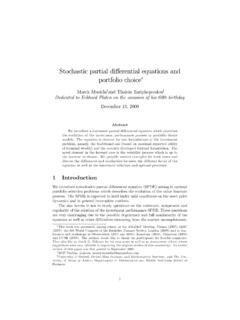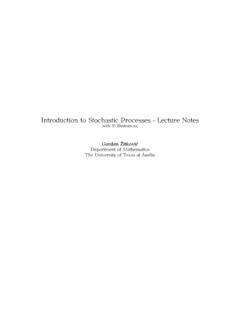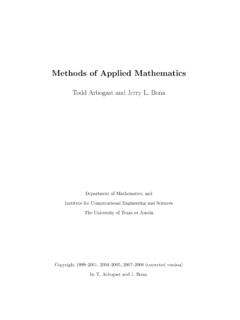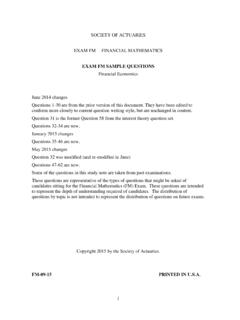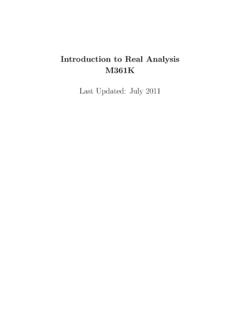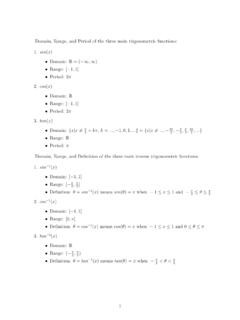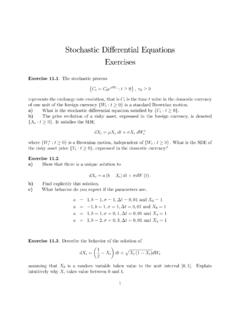Transcription of Stochastic partial di⁄erential equations and portfolio choice
1 Stochastic partial di erential equations andportfolio choiceM. Musiela and T. ZariphopoulouyBNP Paribas, London and the University of Texas at AustinOctober 2007 Preliminary reportComments welcomeAbstractIn this paper we derive a Stochastic partial di erential equation whosesolutions are processes relevant to the portfolio choice problem. The mar-ket is incomplete and asset prices are modelled as Ito processes. Weprovide solutions of the SPDE for various choices of its volatility coe -cient. We also show how to imbed the classical Merton problem into Investment performance measurementThe market environment consists of one riskless andkrisky securities. The riskysecurities are stocks and their prices are modelled as Ito processes. Namely, fori= 1; :::; k;the priceSiof theithrisky asset solvesdSit=Sit0@ itdt+dXj=1 jitdWjt1A(1)withSi0>0:The processW= W1; :::; Wd is a standardd dimensionalBrownian motion, de ned on a ltered probability space( ;F;P):For sim-plicity, it is assumed that the underlying ltration,Ft, coincides with the onegenerated by the Brownian motion, that isFt= (Ws: 0 s t):The coe cients iand i; i= 1; :::; k, followFt adapted processes withvalues inRandRd, respectively.
2 For brevity, we use tto denote the volatility The second author acknowledges partial support from theNational Science Foundation (NSF Grants: DMS-0091946 and DMS-FRG-0456118).1matrix, thed krandom matrix jit ;whoseithcolumn represents thevolatility itof theithrisky asset. We may, then, alternatively write (1) asdSit=Sit itdt+ it dWt :The riskless asset, the savings account, has the price processBsatisfyingdBt=rtBtdtwithB0= 1;and for a nonnegative,Ft adapted interest rate processrt:Themarket coe cients, ; andr;are taken to be bounded (by a deterministicconstant).It is postulated that there exists anFt adapted process ;known as themarket price of risk, taking values inRdand such that the equality it rt=dXj=1 jit jt= it tis satis ed fort 0, for alli= 1; :::; k:Using vector and matrix notation, theabove becomes t rt1= Tt t(2)where Tstands for the matrix transpose of , and1denotes thed dimensionalvector with every component equal to one.
3 We also assume that, for allt >0;ERt0j s +s sj2ds <1:Starting att= 0with an initial endowmentx2 R, the investor invests atany timet >0in the risky and riskless assets. The present value of the amountsinvested are denoted, respectively, by 0tand it,i= 1; :::; present value of her investment is, then, given byXt=Pki=0 it:Wewill refer toXas the discounted wealth. The investment strategies will playthe role of control processes and are taken to satisfy the standard assumptionof being self- nancing, fors 0,Xs=x+kXi=1Zs0 iu iu ru du+kXi=1Zs0 iu iu dWu:Writing the above in di erential form, yields the evolution of the discountedwealth,dXt=kXi=1 it it ( tdt+dWt) = t t ( tdt+dWt);(3)where the (column) vector, t= it;i= 1; :::; k :The set of admissible strategies consists of all self- nancingFt adaptedprocesses tsuch thatEPRs0j t tj2dt <1, fors 0. In order to analyze theattractiveness of these policies, the authors introduced (see [4], [6] as well as[3]) the concept of theperformance/value recall its de nition belowand refer the reader to [6] for further nition 1 AnFt adapted processU(x; t)is a performance/value processif:i) for eacht 0the mappingx!
4 U(x; t)fromRtoRis increasing andconcaveii) for eacht 0and each self- nancing strategy, ;EP(U(X t; t))+<+1;iii) for each self- nancing strategy, ;EP(U(X s; s)jFt) U(X t; t); s tiv) there exists a self- nancing strategy, ;for whichEP U X s; s Ft =U X t; t ; s t:2 Stochastic PDE for the performance processIn this section we derive a Stochastic partial di erential equation whose solu-tions yield performance processes. We recall that and are, respectively, thevolatility matrix and the market price of 2 LetU(x; t)2 Ftbe such that the mappingx!U(x; t)isincreasing and concave for allx 0. Assume that the processU(x; t)satis esdU=12j +A(U +a)j2A2 Udt+a dW;(4)where the volatility processaisFt adapted,d dimensional, and the operatorAstands for the spatial partial derivative,A=@@x:ThenU(x; t)is a perfor-mance/value +A(U +a)j2A2 Uand note thatU(x; t)can be written as followsdU(x; t) =b(x; t)dt+a(x; t) dWt;whereb; aareFt adapted processes taking values inRandRd; the wealth processX (cf.
5 (3)) generated using an admissiblestrategy :Applying the Ito-Ventzell formula toUt(X t; t)(assuming enoughregularity for the involved quantities) we obtaindU(X t; t) =b(X t; t)dt+a(X t; t) dWt1 The matrix +appearing in the sequel denotes the Moore-Penrose pseudoinverse of (see, for example, [8]).3+Ux(X t; t)dX t+12 Uxx(X t; t)dhX it+ax(X t; t) dhW; X it= b(X t; t) + t t (Ux(X t; t) t+ax(X t; t)) +12 Uxx(X t; t)j t tj2 dt+ (a(X t; t) +Ux(X t; t) t t) dWt= b(X t; t) + t t t +t(Ux(X t; t) t+ax(X t; t)) +12 Uxx(X t; t)j t tj2 dt+ (a(X t; t) +Ux(X t; t) t t) dWt=12 Uxx(X t; t) t t+ t +tUx(X t; t) t+ax(X t; t)Uxx(X t; t) 2dt+ (a(X t; t) +Ux(X t; t) t t) dWt:Obviously the processU(X t; t); t 0is a (local) supermartingale for every and a (local) martingale for t= +tUx X t; t t+ax X t; t Uxx(X t; t);whereX is the solution of (3) with being used. Therefore the conditionsiii)and iv)of De nition 1 are satis that the volatility coe cientamay depend ont; x,Uand its deriv-atives.
6 In that sense the processUcan be viewed as a solution to a stochasticPDE(4)or, alternatively, as an evolution equation in in nite dimension. Theinitial condition, sayu0(x);represents the investor s current utility. The volatil-ity processarepresents the uncertainty about the future shape of this utilityfunction. From the modelling perspective, one can see analogy to term struc-ture, where the initial condition is the current forward curve as traded in themarket, while the volatility captures the way the curve moves from one day tothe next. However the analogy stops here. One has to develop di erent meth-ods to recover the initial conditionu0and the volatilityafor the investmentproblem governed by(4):The performance processU(x; t)may be de ned on[0;1)or on[0; T]fora xedT:In the former case, the investor needs to specify his current utilityu0and its volatilitya. In the latter, he has to specify his utility, sayuT;forthe investment horizonTand recovers his current utility and its volatility fromthe analysis of the value function.]
7 We will refer to a forward and backwardformulations, as a Stochastic PDE, (4) poses several challenges. It is fully nonlinearandnot(degenerate) elliptic; the latter is a direct consequence of the "forwardin time" nature of the involved Stochastic optimization problem. Thus, existingresults of existence, uniqueness and regularity of weak (viscosity) solutions arenot directly applicable. An additional di culty comes from the fact that thevolatility coe cient may depend on higher order derivatives ofU;in which case4the SPDE cannot be turned into a regular PDE with random coe cients, usingthe method of Stochastic the following sections we construct explicit solutions for di erent choicesof the coe cientain the forward formulation. The cases we consider coverseveral known cases, among which the ones constructed in [5], [6], [1] and [2].We, also, show how to link our approach to the classical, Merton type, backwardformulation of the utility optimization problem.
8 In what follows, however, we rst analyze the optimal policy and the dynamics of the optimal wealth process,independently of the 3 LetU(x; t)be a solution to the SPDE (4) such that the mappingx!U(x; t)is increasing and concave. The optimal allocation vector is given,fort >0;by t= +A(U +a)A2U(X t; t);(5)whereX is the optimal wealth solvingdX t= +A(U +a)A2U(X t; t) ( tdt+dWt):(6)3 Backward formulationIn the rst instance, we consider a special case when the model coe cientsr; and are deterministic functions of a nite dimensional di usion processY:Namely, we assume thatrt=r(Yt); t= (Yt)and t= (Yt), wherer; and smooth functions, whileYis a ( nite dimensional) di usion given bydYt= (Yt)dt+ T(Yt)dWt:In the backward formulation of the portfolio problem, the investor chooses theutility functionuT(x)for the investment horizonT:The value function of thecorresponding utility maximization problem is given byV(x; y; t;T) = sup E(uT(X T)jX t=x; Yt=y):Under our assumptions, the functionVsatis esVt+ sup 12j j2 Vxx+ Vx+ Vxy+12 T Vyy+ Vy = 0;together with the conditionV(x; y; T.)
9 T) =uT(x):To clarify the notation,Vyis the vector of rst derivatives of the functionVwith respect to the coordinatesof the vectory; Vyyis the matrix of second derivatives andVxyis the derivativeof the vectorVywith respectx:The above equation can be simpli ed , because (I +) = 0for any ;we getVt+ sup 12j j2 Vxx+ +( Vx+ Vxy) +12 T Vyy+ Vy = 0:5 The maximum is attained at = +Vx + VxyVxx:In turn, we get the following equationVt 12j +(Vx + Vxy)j2 Vxx+12 T Vyy+ Vy= 0(7)with the terminal conditionV(x; y; T;T) =uT(x):Lemma 4 LetV(x; y; t;T)be a solution to(7)withV(x; y; T;T) =uT(x)which is increasing and concave inx:Then, the mappingx!V(x; y; t;T)isincreasing and concave inxfor ally; tandT:Moreover,limt!TVy(x; y; t;T) = 0for allxandy:Now we are ready to prove the 5 Let the functionV(x; y; t;T)be given by(7)and letU(x; t) =V(x; Yt; t;T):The processU(x; t)satis es(4)and hence is a performance Ito formula we getdU(x; t) =Vtdt+Vy dY+12 Vyy dhYi= 12j +(Vx + Vxy)j2 Vxx 12 T Vyy Vy!
10 Dt+Vy dt+ TdW +12 Vyy T dt=12j +(Vx + Vxy)j2 Vxxdt+ Vy dW:Observe thatUx=Vx; Uxx=Vxxand witha= Vywe can write thatdU=12j +(Ux +ax)j2 Uxxdt+a dW;and hence the statement above result shows how to imbed the classical Merton problem into ourformulation. The investor s utility is speci ed for the investment horizonT:The6investor s current utility is in fact given by the value function at timet= 0;namely,V(x; y;0;T). It depends on the time horizonTas well as on the level ofthe variableythe investor has to choose. The quantitya= Vy;associated inthe classical literature with the excess hedging demand portfolio , represents inour framework the volatility of the utility. Note that the volatility converges to0whenttends toT:This is to be expected because the (backward) performanceprocessU(x; t)takes the deterministic valueuT(x)fort=T:4 Forward formulationFirst, we focus on the case that the volatility coe cientais a function ofx; UandUx;namely,a=F(x; U; Ux);(8)for some simple choices ofF.
